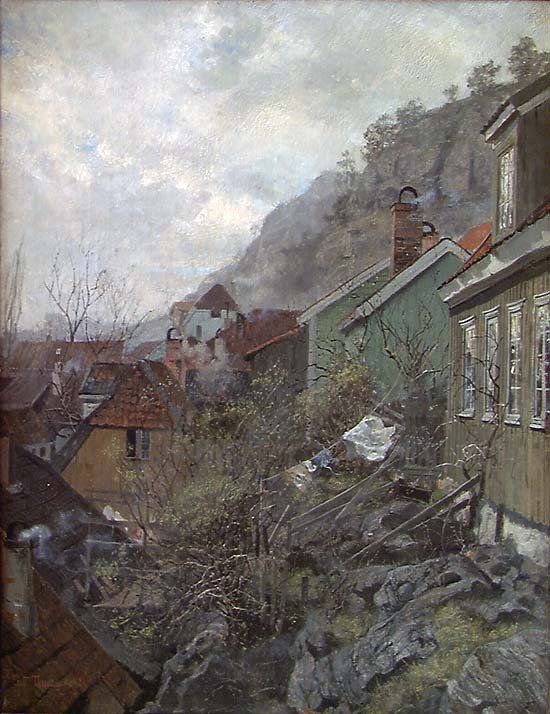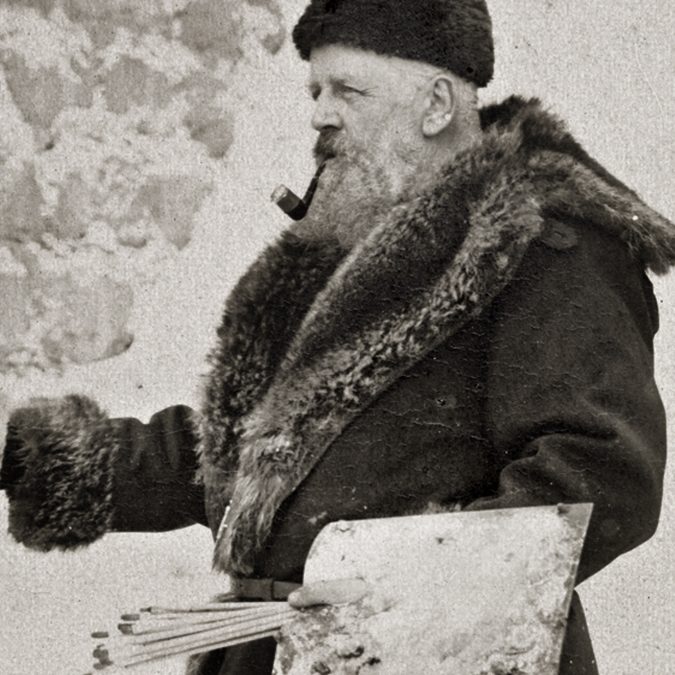
Sentimentality in art was very popular during Victorian times. I have looked at many artists whose motifs often depicted “cute” little boys and cute little girls in pretty dresses.

Even the great artists, such as John Everett Millais, with his famous 1886 painting Bubbles, realised such paintings of young children were money-spinners. This painting shows a boy blowing bubbles with a pipe and a bowl of soap suds. The boy was Millais’ four-year-old grandson, Willie James. A. & F. Pears bought the painting from Millais in 1886.

Another motif which was popular at the time in Victorian England was small animals, especially dogs. Add to that motif a touch of pathos and the painting is sold! My artist today was a master of such depictions. Let me introduce you to Briton Rivière.

Briton Rivière was born in St Pancras, London on August 14th 1840. He was the youngest child and only son of William Rivière, who was the third of twelve children, and Anne Rivière (née Jarvis) whom he had married in 1830. Briton had three elder sisters, Marion born in 1833, Henrietta Fanny born in 1835 and Annette Louise born in 1837. Briton’s love of art probably came from his parents. His mother was a still-life painter and his father trained to be an artist at the Royal Academy when he was eighteen years old and two years later began to exhibit his work at the Academy.

William Rivière was appointed Master of the drawing academy at Cheltenham College in 1849, a town at which the family then lived. There he succeeded in establishing a drawing-school which was unique of its kind, and was hailed as the best school of art outside of London. Briton Rivière’s paternal uncle Henry Parsons Rivière was also a noted watercolourist, who had exhibited his paintings at the Royal Watercolour Society, London, and the Royal Birmingham Society of Artists.
Much happened in his family life when Briton was thirteen years of age. In 1853 his eldest sister Marion married and a year later his sister Henrietta, then aged nineteen died in Brighton

Briton’s father resigned from Cheltenham College in 1859, and he, his wife and two children, Annette and Briton left Cheltenham and moved to Park Town, Oxford, where he convinced the University to initiate the study of art for undergraduates and he set up his own drawing school. His son Briton studied painting and drawing at the university. Briton Rivière had some of his works hung at the Royal Academy exhibitions from 1858 onwards but he had yet to make a breakthrough with his paintings. That all changed in 1869 when he exhibited his work, The Long Sleep. The painting pulled at the heartstrings of the viewers and was an immediate hit with Victorian art lovers. It was to be first of many which featured domestic animals and their owners intertwined with a sense of pathos. In this work we see and old man sitting in his chair besides the fire. His head lolls forward on to his chest. His clay pipe, which has slipped from his life-less fingers, lies broken on the stone floor. He is not asleep. He has died and his two faithful friends, his dogs, become agitated at his lack of movement. One jumps up to lick his face in the hope that this may awaken their master but, of course, to no avail.

In 1878 Rivière completed a work entitled Sympathy. In this work we see a young girl sitting on stairs, all alone except for her beloved pet. The story behind the painting is that she has been naughty and, as punishment, has been sent to sit on the “naughty step”. The only comfort she receives is from her beloved four-legged friend.

His work, Companions in Misfortune, similarly depicts a solitary human having only his animal friend as company and for many observers of the work, they can empathise with the man as in their lives they often only have the love of an animal to look forward to.

Rivière’s painting were not always sad depictions as he had the ability to inject humour into his depictions as we see in his 1882 painting Giants at Play. Rivière depicts three men at rest, enjoying themselves by playing with a tiny young bull-pup. They tantalise the dog by dragging a feather attached to a piece of string always just out of reach of the puppy. Just a harmless game or as some will have you believe it may have been the initial stage in the training that will prepare the dog for fighting and baiting

Another humorous painting was Rivière’s 1888 work entitled A Blockade Runner in which we see a cat escape across the top of a wall to escape the clutches of its four canine assailants.

In 1894, in total contrast to these works Rivière exhibited at the Royal Academy a completely different type of work with his painting Beyond Man’s Footsteps. The setting for the painting is the Arctic, a region where no human had ventured but through Rivière’s depiction the viewer was able to imagine what it was like to be in this bleak and remote region. The foreground is dark and shadowy which contrasts with the colourful beauty of the sky brought about by the setting sun in the background. Atop the overhanging rock we see a solitary polar bear looking out over its terrain. It is thought that Rivière based the depiction of the animal on sketches he made of a polar bear he saw in London’s Regent Park zoo. The depiction of Rivière’s Arctic, free of mankind, is awesome. The Norwegian explorer, scientist, diplomat, humanitarian, and Nobel Peace Prize laureate Fridtjof Nansen’s narrative of The First Crossing of Greenland was written and published in 1890 and it is believed that Rivière had read the translated version and based his painting on what he had read. One passage from the book described what Nansen had witnessed during his journey:
“…when the sun sank lowest, and set the heavens in a blaze … the wild beauty of the scene was raised to its highest’. At the foot of the ‘spires’ of huge, glittering icebergs, ‘there were marvellous effects and tints of blue, ranging to the deepest ultramarine … a floating fairy palace, built of sapphires, about the sides of which brooks ran and cascades fell … in fantastic forms…”

During the 1870’s Rivière began to exhibit Classical and Religious paintings. His depiction of this classic story of George and the Dragon is somewhat unusual. Normally Saint George would be portrayed astride his horse, lance in hand but in Rivière’s work we see the dragon’s conqueror lying on the ground, exhausted, close to his fallen adversary.

His painting Daniel in the Lion’s Den was based on the biblical story about Daniel which tells how Daniel is raised to high office by his royal master Darius the Mede, but jealous rivals trick Darius into issuing a decree which condemns Daniel to death. Hoping for Daniel’s deliverance, but unable to save him, the king has him cast into the pit of lions. At daybreak he hurries back, asking if God had saved his friend. In the Old Testament (Daniel 6:20-22) the story unfolds:
“…When he had come near the den to Daniel, he cried out with a troubled voice. The king spoke and said to Daniel, “Daniel, servant of the living God, has your God, whom you constantly serve, been able to deliver you from the lions?”
Then Daniel spoke to the king, “O king, live forever!
“My God sent His angel and shut the lions’ mouths and they have not harmed me, in as much as I was found innocent before Him; and also toward you, O king, I have committed no crime…”

However, for most people the name Briton Rivière was synonymous with painting of animals and in an interview, he did for the Chums Boys Annual in August 1897 he explained how he mastered the drawing of both wild and domesticated animals:
“…I have always been a great lover of dogs but I have worked at them so much that I’ve grown tired of having them about me. However, you can never paint a dog unless you are fond of it. I never work from a dog without the assistance of a man who is well acquainted with animals….. Collies, I think, are the most restless dogs….greyhounds are also very restless, and so are fox terriers….. The only way to paint wild animals is to gradually accumulate a large number of studies and a great knowledge of the animal itself, before you can paint its picture…… I paint from dead animals as well as from live ones. I have had the body of a fine lioness in my studio….. I have done a great deal of work in the dissecting rooms at the Zoological Gardens from time to time…”

Early in his career, Rivière became an illustrator for the Punch magazine. Briton Rivière married Mary Alice Dobell in 1867. She too was a talented painter. The couple went on to have seven children, four sons, Hugh Goldwyn, Clive, Philip Lyle, and Bernard and three daughters, Millicent Alice, Evelyn, and Theodora. In 1878, when he was thirty-eight, Rivière was elected an Associate of the Royal Academy of Arts and three years later, a Royal Academician. He stood for election to become President of the Royal Academy but failed in his bid – the position being awarded to Edward John Poynter.
Briton Rivière died in London on April 20th 1920, aged seventy-nine.


























